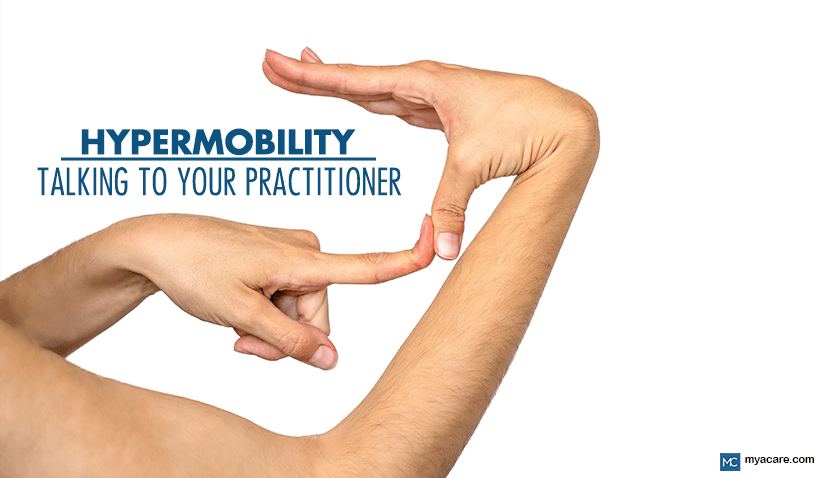Bridging the Gap: Hypermobility Patient-Practitioner Communication

Medically Reviewed by Dr. Rae Osborn, Ph.D.
Why Comprehensive Evaluation Matters
Communicating Needs Effectively
Hypermobility typically occurs when a person's joints can move beyond the typical range of motion. Some form of hypermobility, which encompasses a spectrum, reportedly affects between 2% and 57% of people, depending on the population researched and the criteria used. This wide range is largely due to differences in how hypermobility is defined - whether it includes only symptomatic cases such as Hypermobility Spectrum Disorders (HSD) and hypermobile Ehlers-Danlos Syndrome (hEDS), or also asymptomatic joint hypermobility, which is common in children and some ethnic groups. Broader definitions that focus solely on joint flexibility yield higher prevalence rates, while stricter diagnostic criteria that account for systemic involvement and symptoms produce lower estimates.
The presentation of hypermobility varies from person to person, as the spectrum includes different subtypes. This is why hypermobile patients need a specialized and customized approach to treatment in order to achieve improved outcomes. This article provides information to help understand the condition as well as to communicate effectively with your practitioner so as to initiate a treatment program.
Understanding Hypermobility
Hypermobility, in general, is when joints move more than usual. Hypermobility spectrum disorder (HSD) refers to hypermobility of the joints due to a connective tissue disorder. One example is Ehlers-Danlos syndrome (EDS), which is one type on the spectrum of connective tissue disorders.
Depending on the type of hypermobility, the person may also have other signs, such as problems with the cardiovascular system and balance issues. Patients with cervical spine joint hypermobility often experience headaches. Also, an emerging body of research suggests a potential link between scoliosis and hypermobility.
Challenges in Treating Hypermobile Patients
Understanding the challenges of treating hypermobility is crucial when meeting with your doctor to discuss a course of treatment.
The heterogeneity of hypermobile conditions contributes to the difficulty in treating hypermobility. Diagnosing hypermobility as a cause of pain has been rather complex. Physicians may also be inexperienced regarding HSD. Other difficulties in treating hypermobility include:
- Injury risk – The hypermobility of joints can mean instability and possible dislocation and subluxation. Performing surgery on unstable joints can pose challenges and may necessitate further surgical intervention.
- Pain – Hypermobility-induced pain needs to be considered when deciding on a treatment program, as physical therapy is a vital component of it. For instance, you may have hypermobility-related back pain, making exercising difficult. Back pain can sometimes occur in patients who have a hypermobile spine. Without proper caution, certain exercises can increase the risk of injury in people with hypermobility.
- Poor proprioception – In patients with EDS, proprioception is adversely impacted. This complicates treatment and necessitates proprioceptive training.
- Motor control challenges – Children with hypermobility may have developmental coordination disorder (DCD). This makes motor control more difficult in these patients. Treatment may need to be adjusted accordingly for children who have developmental delays.
- Psychosocial factors – Psychological factors, such as anxiety, depression, apathy, and lack of sleep, are common in patients with hypermobility conditions. Ignoring these psychological issues may reduce treatment efficacy. Patients with hypermobility may also experience fear of movement, which needs to be overcome for therapy to work.
Comprehensive Evaluation: Significance & Components
Evaluation of hypermobile joints using a Beighton score is an important part of diagnosis and planning for hypermobility therapy. Muscle strength assessment and functional testing should be performed in patients with hypermobility conditions, such as EDS. An isokinetic dynamometer can be used to assess muscle strength. Muscle and bone mass may be assessed using dual x-ray absorptiometry.
Neurological screening is also advisable since some types of hypermobility can lead to neck instability, resulting in neurological signs.
Can a Physical Therapist diagnose Hypermobility?
Usually, a doctor will diagnose hypermobility and then refer you to a physiotherapist. However, physiotherapists often notice the signs that indicate hypermobility in the joints and also further evaluate patients who have been recently diagnosed. The person diagnosing your condition should communicate their findings to you and be able to explain the types of therapies they recommend, as well as the rationale behind them.
How Can Patients Communicate Their Needs Effectively?
It can be beneficial when patients can thoroughly explain their health concerns. Detailed explanations often contribute to more positive treatment outcomes.
The following pointers can be helpful to discuss your symptoms with your care provider.
- Maintain a symptom diary - If you suspect hypermobility, a symptom diary can serve as a record for your healthcare practitioner’s review.
- Explain your limitations - Communicate what causes your pain and the daily activities you are struggling with.
- Explain what has worked, or not worked, in the past - This collaboration with the therapist can lead to a more effective treatment program.
- Request a referral to a physical therapist specializing in hypermobility - Physical therapists with experience in hypermobility are better equipped to recommend suitable treatments and help reduce the risk of discomfort or injury during care.
- Ask purposeful questions, and the ‘why’ behind recommended treatments - Find out from your therapist the rationale behind the treatment approach being taken.
- Request clear demonstrations of exercises - This will help improve your chances of recovery while minimizing the risk of injury.
Treatment Strategies or Goals
Effective treatment relies on close collaboration with the physiotherapist. You can discuss possible strategies and goals with your therapist, who will customize treatment to your specific case.
These are the possible goals that a physiotherapist may outline for you when discussing your treatment plan.
- Prioritize Stability Over Flexibility: This is crucial, as joint instability associated with hypermobility syndrome can lead to frequent dislocations, worsening the patient’s condition. Physical therapy for hypermobility syndrome should aim to help stabilize joints. For instance, with hypermobility in the neck, a cervical collar may be needed to stabilize the neck.
- Enhance Proprioception and Neuromuscular Control: Hypermobility treatments, including proprioception exercises, can be helpful for EDS patients. Neuromuscular exercises can help improve fine motor control and increase joint stability.
- Chiropractic and Manual Therapy Considerations:
- Chiropractic care may help some patients with benign joint hypermobility.
- Hypermobility and chiropractic care research has shown that forceful manipulations should be avoided. This is particularly true when considering chiropractic care for Ehlers-Danlos syndrome.
- Manual therapy can be used as part of a multidisciplinary approach to treat EDS and reduce pain. However, manual therapy should be approached cautiously in EDS patients due to tissue fragility. Only gentle, modified techniques should be used.
- Address Systemic and Fatigue-Related Issues: Fatigue may be due to muscle weakness or dysautonomia. For individuals with hypermobility, strength training is important; strengthening muscles and addressing dysautonomia through various approaches can be beneficial.
- Manage Pain with Multimodal Strategies: This is a recommended approach, for example, for patients with back pain due to hypermobility. In such cases, a multidisciplinary approach is recommended.
- Physical therapy for Ehlers-Danlos also focuses on reducing discomfort and improving function. Exercise for hypermobility needs to be done with care to prevent further pain, as patients may quit the program if they feel worse.
- There are also drug-based approaches that might be prescribed for pain associated with hypermobility.
- Practice Joint Protection and Safe Movement: This forms part of Ehlers-Danlos syndrome supportive therapy, where the physiotherapist teaches the patient how to move safely to avoid further injury and strengthen the joints.
- Psychological Support: In addition to teaching hypermobility exercises to patients, recognizing the psychological aspect and providing support is an important component of treatment. Your physio might advise discussing psychological issues with your primary care doctor for recommendations.
Risks of Inadequately Informed Treatment
Without proper guidance, certain treatments, exercises, or activities may worsen symptoms or increase the risk of injury in individuals with hypermobility.
There is a risk of musculoskeletal injuries in people with hypermobility syndrome if care is not taken during treatment and when playing certain sports. It is essential to avoid certain exercises. Talk to your physio if you are concerned about the type of exercises you are doing. Regular treatment reviews and feedback are essential for optimal results
- Hypermobility exercises to avoid include high-impact activities like running and jumping. Heavy weightlifting and contact sports may not be ideal for individuals with hypermobility syndrome.
- Caution should be exercised when practicing yoga for hypermobility, as it may lead to increased discomfort afterward. Certain techniques can also increase the chance of subluxation if you have joint instability.
- Discomfort may lead to increased muscle guarding. Mindfulness and minor posture adjustments may help, as would working with a yoga practitioner who is aware of your limitations.
- There may be vascular and systemic risks in certain EDS subtypes. For instance, depending on the type of EDS a person has, there is a risk of organ rupture.
- Chiropractic care is sometimes contraindicated for hypermobility. Manipulation can result in more pain and joint dislocations when Ehlers-Danlos patients seek chiropractic care. Finding a good EDS chiropractor is important, and only gentle manipulations should be incorporated.
- Diagnostic and management delays can result in more emotional distress.
How to Foster a Collaborative Partnership Between Patient and Practitioner
Open communication and mutual respect between the patient and practitioner are important for achieving positive outcomes in the treatment of hypermobility syndrome. Effective communication is crucial when consulting a physiotherapist and planning physical therapy for hypermobility. Discuss any concerns you may have about any treatment program or plan that your physiotherapist recommends.
Continual reassessment and flexibility in treatment plans are essential. Regular monitoring often leads to adjustments based on how the patient is responding. As a patient, you should discuss any recommended changes to your treatment with your therapist.
Long-term management and self-management strategies are other vital aspects of treating hypermobility syndromes.
To search for the best Orthopedics Healthcare Providers in Croatia, Germany, India, Malaysia, Singapore, Spain, Thailand, Turkey, the UAE, UK, and the USA, please use the Mya Care search engine.
To search for the best healthcare providers worldwide, please use the Mya Care search engine.
The Mya Care Editorial Team comprises medical doctors and qualified professionals with a background in healthcare, dedicated to delivering trustworthy, evidence-based health content.
Our team draws on authoritative sources, including systematic reviews published in top-tier medical journals, the latest academic and professional books by renowned experts, and official guidelines from authoritative global health organizations. This rigorous process ensures every article reflects current medical standards and is regularly updated to include the latest healthcare insights.

Dr. Rae Osborn has a Ph.D. in Biology from the University of Texas at Arlington. She was a tenured Associate Professor of Biology at Northwestern State University, where she taught many courses to Pre-nursing and Pre-medical students. She has written extensively on medical conditions and healthy lifestyle topics, including nutrition. She is from South Africa but lived and taught in the United States for 18 years.
References:
Featured Blogs



